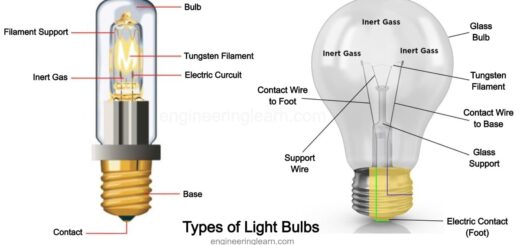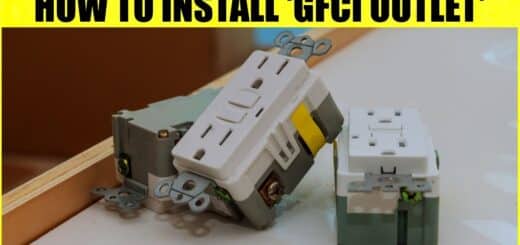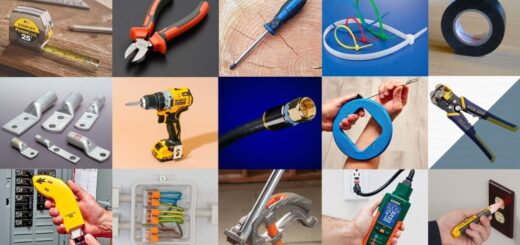14 Parts of a Lamp and Their Uses [Explained with Diagram]
![Parts of a Lamp and Their Uses [Explained with Diagram]](https://engineeringlearn.com/wp-content/uploads/2023/07/Parts-of-Lamp-1024x539.jpg)
Introduction
Parts of a Lamp and Their Uses [Explained with Diagram]: – Lamps are a typical and common household item mostly used in every home. You could have no less than one in your home, and probably there are several lamps conveniently placed around your home to provide light where you need it. The lamp is one of the enduring parts of furniture in your living room or even in your study room. It’s been in existence for a long time now, yet remains a lot of a typical fixture in many homes and offices. These days, a lamp isn’t just a source of light and heat. It additionally fills different needs. It can improve the look and feel of any room of your home or office.
What is a Lamp?
The lamp is one sort of light source that includes an element or component for light-emitting in a tube or external bulb which typically generates radiation in the visible spectrum. Furthermore, the term ‘bulb’ is utilized to represent a light however it is an external glass part that includes or incorporates the light source. Lamps can assist us with seeing better in dark or diminished conditions, for example, around evening time, indoors, or in tunnels.
Lamps can create a comfortable and relaxing environment by adjusting or changing the temperature, intensity, and color of the light. They can likewise impact our moods, emotions, etc. by mimicking or impersonating natural light cycles. Lamps can add aesthetic worth or value and style to any space by creating focal points, featuring highlights, and complementing the overall theme. Lamps can forestall mishaps and injuries by making perils more visible and warning us of potential dangers. They can likewise prevent crime and defacement by creating a sense that all is well with the security and reconnaissance.
Parts of a Lamp
Assuming you are looking to replace or supplant parts of an old lamp that you have had for a considerable length of time or need to really focus on your lamp, understanding what the individual parts of your lamp are will clearly be useful. We should jump straight into it and inspect what each part of the lamp is called and what each part is responsible for.
- Lock
- Lampshade Fitting
- Lampshade
- Harp and Harp Holder
- Bulb
- Insulation Sleeve
- Socket Shell and Lamp Holder
- Switch
- Threaded Tube
- Lamp Body
- Plug
- Lamp Base
- Anti-slip Material
- Power Supply
1. Lock: ( Parts of Lamp )
The lock on a lampshade is responsible and liable for locking the lampshade firmly in one place.
2. Lampshade Fitting: ( Parts of Lamp )
The lampshade fitting is the lampshade’s exoskeleton, which characterizes your lampshade’s general shape as well as structure.
3. Lampshade: ( Parts of Lamp )
A Lamp shade’s purpose is to safeguard the eye from the bulb’s glare and to direct and coordinate light from the bulb in the lamp into the room. There are many styles, colors, and designs of lampshades. It is likewise constructed from different materials that range from fabric, plastic, metal, and some of the time even glass. The lampshade is one of those dual-purpose includes that can either represent the make or break the stylistic layout in a room.
In the event that your lamp will fulfill most part decorative purposes, you can go for a cloth lampshade. They’re exceptionally flexible, accessible in many colors and designs and they require little maintenance.
4. Harp and Harp Holder: ( Parts of Lamp )
The purpose behind the harp with the harp holder is to provide vertical support for the shade and light bulb. The harp with the harp holder will upward hold your lampshade and light bulb.
5. Bulb: ( Parts of Lamp )
The purpose of the bulb is to provide light since, without a light source, your lampshade is useless and fills in as a decorative piece, rather than a functional piece. Most light fixtures and lamps utilize standard 100-watt 120-volt light bulbs. Newer light bulbs are energy-efficient and last quite a bit longer than regular ones.
A few light bulbs are intended for decorative purposes and add a touch of elegance to a room. The shape and color of the decorative bulbs might contrast with traditional light bulbs. You could find decorative bulbs that look like candles with an imitation fire. A few bulbs could try and be globe-molded, a variety of traditional pear-shaped light bulbs. You could likewise track down novelty bulbs with exceptional shapes and painted designs.
6. Insulation Sleeve: ( Parts of Lamp )
An insulation Sleeve or insulator is by and large a molded paper sleeve that snugly fits between the light socket and the metal socket sleeve outwardly. The insulation sleeve is moreover intended to safeguard the lamp’s electrical wiring from high temperatures and abrasion that could cause electrical damage to the lamp and its inward electrical parts.
7. Socket Shell and Lamp Holder: ( Parts of Lamp )
One of the main parts of your lampshade is the socket and its socket shell. The socket is utilized to provide a space for the light bulb to interface with the lamp.
Few out of every lamp will feature a socket shell, yet all lamps should have a socket for the light bulb to be fitted into place. The lamp socket or attachment can supply electricity to the light bulb with a laid out contact made.
There are different sockets/lamp holders to suit all kinds of light bulbs: –
(i) Wedge Base Lamp Holders
These lamp holders are designed and intended to oblige the wedge-shaped bulb base with warped-over wires. These sockets are accessible in several materials and mounting styles.
(ii) Mogul-Base Lamp Holders
These sockets are projected from sturdy and durable porcelain that permits them to endure high operating temperatures from light bulbs.
(iii) Metal Halide Lamp Holders
These sockets are made from durable and strong materials to accommodate high-intensity discharge lamps.
(iv) Medium-Base Lamp Holders
These are the absolutely most common and broadly utilized lamp holders and light bulbs. They are additionally referred to as Edison base lamp holders.
(v) Halogen Lamp Holders
Halogen lamp holders are accessible in two voltages, specifically, line voltage and low voltage, and are accessible in various sizes and shapes. The most widely recognized ones are round and rectangular.
(vi) Fluorescent Lamp Holders
These sockets can oblige linear, twisted, and compact bulbs. They could have a solitary pin or two pins and are either shunted or non-shunted.
(vii) Bayonet Base Lamp Holder
This socket comprises two pins that allow for the locking and twisting of the bulb into place.
8. Switch: ( Parts of Lamp )
The switch is most likely an essential part of the lampshade. The switch is generally integrated into the lamp or separated and mounted into a nearby wall. Without a switch, you will not be able to activate the electrical current to flow through the light bulb.
There are two switch varieties with various functional capabilities. Push-button, toggle switches, and rocker switches are commonly tracked down in many homes. These switches have just two positions, on and off.
Then again, dimmer switches to control the brightness and permit the user to adjust light levels. These lamps are useful for people that could do without involving lights as a light source for reading.
There is likewise a modern variation on the switch that is touch-activated. These switches can be turned on or off by a simple touch to the lamp’s base. Furthermore, these kinds of switches allow for the adjustment of the bulb’s brightness, similar to a dimmer switch. There are different lamps where the switch is integrated into the plug.
9. Threaded Tube: ( Parts of Lamp )
The Threaded tube part is optional for most lamps. Nonetheless, the functional capability of the threaded tube is to connect or associate the wiring from the body to the base and at last to the bulb.
10. Lamp Body: ( Parts of Lamp )
In specific lamps, similar to a table lamp, the body is the mid to lower part of the lamp. On the off chance that you want a decorative lamp, this part is essential as it can influence the look of the lower design of the lamp or even the overall look of your lamp.
11. Plug: ( Parts of Lamp )
The electrical supply to the lamp is provided by a length of cord that connects or interfaces to an electrical outlet. Consequently, the essential function of the plug is to take into consideration an electrical flow to move through the lampshade by means of the electrical cord. Notwithstanding, a few lamps have light fittings installed on a wall or ceiling with the wire connected directly to the electrical system.
12. Lamp Base: ( Parts of Lamp )
The base provides the lamp with a large portion of its physical form. It very well might be a simple stand or more ornate ceramics. The lamp owes its shape, form, as well as support to the base of lamp. Like the lampshade, the lamp’s base is functional and stylish.
13. Anti-slip Material: ( Parts of Lamp )
The anti-slip material can be found underneath the lamp’s base, and its functional capability is to provide a non-slip surface to the lamp with the goal that it doesn’t slide and slip off surfaces. This material can be made using felt or rubber to keep the lamp set up on any surface.
14. Power Supply: ( Parts of Lamp )
The power of a lamp is commonly provided by a simple cord connecting and interfacing with an electric outlet. However, some lamps have their light fixtures installed on a ceiling roof or wall with the wire directly connected or associated with the electrical system. There are additionally portable lamps like flashlights and camp lights which utilize batteries as their principal power source. Other like garden or nursery lights as well as emergency flashlights utilize power from sun-based cells or a crank generator.
Conclusion
Lamps are artificial sources of light that can provide visibility, safety, solace, and beauty for different applications. Lamps can be characterized into various sorts in view of their operating guideline, materials utilized, and energy efficiency. The primary types of lamps are glowing lamps, compact fluorescent lamps, fluorescent lamps, smaller fluorescent lights, mercury vapor lights, and metal halide lights. Each sort of lamp enjoys its own benefits and impediments ought to be considered prior to picking the best lamp for a particular purpose. Lamps ought to likewise be utilized and disposed of appropriately to stay away from health and ecological hazards.
Lamps are for the most part easy to clean and maintain. Yet, it doesn’t do any damage on the off chance that you clean it consistently. Regular cleaning of the light can remove dust that might influence the brightness of the bulb. In short, the lamp may be a common fixture in our home, yet it’s highly recommended that you clean it on regular basis to ensure its long life.
Image Source: – homenish













